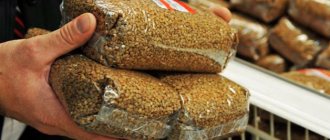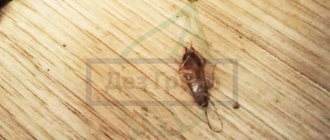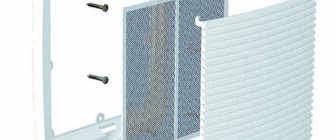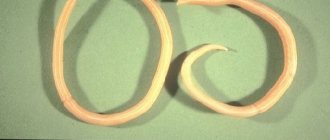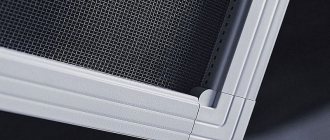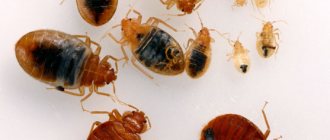Bed bugs are synanthropic blood-sucking parasites. With their bites they cause allergies, skin rashes, and problems with sleep. Nocturnal pests leave chains of wounds on the human body. Bedbug larvae feed next to adult insects. The offspring are no less voracious and harmful. To get rid of the entire colony of parasites, it is necessary to find out the characteristics of their behavior.
Appearance of bed bug larvae
Female bedbugs lay up to several hundred eggs throughout their lives; larvae emerge from the cocoon after 5-10 days. Depending on the air temperature, this period can reach 25 days. Biological features and what it looks like:
- At first, the size of bedbug larvae is 0.5-1.5 mm. The maturation process takes place in 5 stages, at each of them the length of the nymph’s body increases, gradually growing to 4.5-5 mm. The period of reaching full maturity lasts from 1 to 2 months. Development accelerates with increasing temperature and humidity.
- The larvae have a translucent body, initially light yellow. Nymphs are difficult to spot on light-colored bedding and unpainted wood. Individuals that are engorged with blood are more noticeable (their body turns crimson-red). The shell darkens gradually, after 2-4 weeks of development it becomes brown; during this period it is difficult to distinguish the larva from the adult.
Look at the photo to see what the larvae look like.
The body structure of nymphs does not differ from adult bedbugs; they are smaller in size. It has a round shape and consists of 3 parts:
- head;
- breast;
- abdomen.
Sensitive antennae are located on the head. To suck up the blood of the victim, the parasite uses a proboscis; the insect has a piercing-sucking mouth and jaws. In the chest area there are 3 pairs of limbs.
Formation of bedbug colonies
In the house
, insects are mainly kept in shelter, which protects them from predators and the threat of destruction, reduces the impact of the microclimate and provides greater opportunity when choosing a partner. Pheromones help bed bugs gather in colonies; in them they can communicate not only with the help of volatile substances secreted by the glands, but also with the help of mechanoreceptors located on the antennae of insects.
Females often leave colonies in order to find new places to lay eggs and new sources of food. While in the colony, males secrete odorous substances that attract unfertilized females and repel other males.
Although parasites can live separately, after finishing feeding they go to places where they can hide to digest food, molt and lay eggs. Colonies of bedbugs can be detected by the characteristic smell of rotting raspberries. Larvae and adults hide in cracks, behind baseboards, in furniture, household appliances, and sockets.
Over the years of chemical control of bed bugs, their resistance to many types of insecticides has increased. Therefore, scientists are studying the genome of insects in order to create a means of population regulation that is equally effective at all stages of development of blood-sucking insects. Knowing what bedbug larvae and adults look like, you can get rid of the parasites in time, preventing a severe infection of the apartment. Excrement found in the bed, empty chitinous shells and blood stains from crushed insects serve as the basis for treating the room. The laying of eggs is found in places where bedbugs accumulate and is less noticeable. Therefore, the treatment of the apartment should be widespread, especially in hard-to-reach areas of the house.
Stages of development from egg to adult
Like all insects with incomplete metamorphosis, bedbugs do not have a pupal stage. The eggs hatch into larvae that develop into sexually mature individuals. Main stages of development:
- The nymph develops inside the egg (protective shell), which is about 1 mm long. Outwardly, it resembles a translucent grain of rice.
- The emerging larva begins to actively feed. Before the first molt, it has an almost white body; its length increases to 2 mm during the first week of development. When molting, the nymph sheds its outer cover and gradually begins to darken.
- By the end of the second week, the larvae are about 2.5 mm long. A second moult occurs, the body of the parasite becomes even darker.
- The color of the shell becomes light brown after the third molt. The size of the bedbug larva increases to 3 mm.
- After the 4th and 5th molt, the nymph's body becomes a rich brown color. It reaches 4.5 mm in length.
REFERENCE! Unlike adults, nymphs are slow and do not crawl far from the prey. They are hardy, withstand prolonged hunger and temperature changes. The larvae have underdeveloped glands that produce an anesthetic substance for the victim.
Nutritional Features
Food plays a very important role in the life of adult, developing insects. Immediately after birth, bedbug larvae must receive a portion of blood. If this does not happen, development is delayed and molting does not occur.
This happens every time. To move to the next stage of development, bedbugs need active nutrition. Young females feed to lay eggs. Without food, this process stops.
On a note!
The larvae begin parasitizing immediately after birth. It is at this time that a person notices the presence of pests in his home, a large number of spots, and swelling on the body.
The bites of bedbug larvae are somewhat different from those of adults. There is no substance in their body that has an analgesic effect. A person can immediately feel how a bug bites. But the situation is complicated by the fact that pests attack a sleeping person.
Despite the fact that the larva does not inject a special substance into the blood, bite marks and an allergic reaction appear. Red spots and swelling appear on the affected area, all accompanied by severe itching.
Bite marks are placed in pairs, in the form of a path. The larva bites through the skin 2-5 times in search of a capillary with blood. To feed an adult, 7 ml of blood is required, the larva is content with little. But he eats more often. Bites on the body appear at regular intervals.
How are they different from other larvae?
The larvae of house bugs are easily confused with the offspring of other parasites. Distinctive features:
- Young individuals have an external resemblance to ticks, but the latter can be identified by the number of limbs. Bed bugs have 6, ticks have 8.
- The body shape of bedbug larvae can resemble house ants. The offspring of the former are distinguished by a more rounded, wide body. Ant larvae have a bridge between the abdomen and cephalothorax.
- The offspring of cockroaches are active. The main feature is a light spot in the cephalothorax area.
Bed bug larvae are sometimes confused with fleas. The latter are distinguished by jumping ability and high mobility.
Sizes of bedbug nymphs
As the larva grows, its body increases in size and it becomes more noticeable and more similar to adult bedbugs. If an adult has a body length of 5-6 mm, then the body length of a nymph ranges from 1-4 mm. Moreover, if adult bugs are brown, then the nymphs are either yellow with a translucent body, or crimson-red if they have just fed. They need to be distinguished only from eggs - they are white and similar to grains of rice - and from excrement - they are round and black, similar to fixed points.
By the way, hungry nymphs may not be noticed, for example, on an unpainted tree, on the same bed frame, because they blend in with it in color. But the engorged nymphs are very clearly visible, they simply look like running droplets of blood.
If you look at the nymph at all, you can see through the covering of her body the stomach, the black contents of her intestines and other internal organs. When such a larva sucks blood, you can see how this blood flows into the stomach.
Where do the larvae live?
Parasites prefer a quiet lifestyle and are active at night. During the day they hide in dark, warm places in the apartment:
- under the wallpaper;
- in the cracks of the walls;
- under baseboards;
- at the joints of furniture;
- In the bed;
- in clothes;
- in bed linen.
Parasites can live in books, paintings, flower pots, bird cages, and household appliances.
REFERENCE! The presence of bedbugs does not depend on the sanitary condition of the premises.
They can be detected by characteristic black dots - these are traces of excrement, along with them the chitinous shells of larvae and eggs are often present. In a neglected situation, the nest contains an accumulation of adults, nymphs, eggs and waste products. You can recognize the presence of bedbugs in a room by its characteristic smell, reminiscent of fermented compote or cognac.
What do they eat?
Bedbugs are insects that feed on human blood. In case of severe hunger, parasites can attack during the daytime, but more often this occurs between 3 and 8 o’clock in the morning. Habitats should be looked for near the sleeping area, for example, in the upholstery of a sofa.
After nightly activity of parasites, itchy bites remain on the skin, often arranged in the form of paths. Blood stains are found on the linen.
How long do bedbug larvae live? The average lifespan is 1 year, the maximum recorded period is 14 months.
Favorable conditions for the development of larvae
In apartments, the conditions for the development of larvae are most favorable; there are no sudden temperature changes, there are many secluded places, and the humidity level necessary for development is maintained. The most comfortable temperature for parasites is considered to be +20…+25℃. At low temperatures they die.
Bedbug larvae die completely at temperatures of +50℃ and -15℃
IMPORTANT! Under unfavorable conditions, the larva enters suspended animation, slowing down life processes. When conditions change for the better, the nymph comes to life and continues to develop.
Habitats of bedbug larvae and the main methods of combating them
Bedbug larvae live next to adult bedbugs, in their nest, and come out mainly at night to feed. But if the bug is very hungry, it can attack you during the day. The Nymph's bite is more painful than the bites of adult bedbugs. The reason for this is that the larvae do not yet have a sufficient amount of the secretion that anesthetizes the bite site. Therefore, if in a dream you felt quite noticeable pain, then it is most likely the Nymph who bites. The bite of an adult parasite is usually painless and only after a certain period of time the bite site may begin to itch. In order not to confuse bedbug bites with mosquito bites or any other insects, you should know the characteristic distinctive features that are inherent in them. First of all, these are:
- The place where the bug bit swells and turns red, acquiring a slight swelling, and may itch.
- As a rule, there are a lot of bites. One bug bites through the skin several times during one feeding, and, as a rule, there are a lot of them in a home.
- Another characteristic feature is the bites in the form of a “track”. One bug leaves 4-6 bites at a short distance from each other per feeding, unlike mosquitoes. Mosquitoes bite once.
The methods of fighting bedbug larvae are the same as the methods of fighting bedbugs that have reached an adult state. Effective means for destroying the larvae are chemical insecticides such as karbofos, dichlorvos, etc. Of course, insects do not like such drugs and have a detrimental effect on them, but also They also have a poisonous effect on humans. And if you have chosen this method of combating bed bugs, then you must take all precautions, and even better, leave your home for several days during the treatment.
It happens that after using chemical means to combat bedbugs, these parasites return after some time. This happens due to the fact that somewhere there are a few eggs left from which young bugs hatch again. And in order to get rid of them completely, a repeated processing procedure is required.
A photo in which you can see the eggs and larvae of a bed bug. Another effective control method is freezing. It is known that bedbugs die at -20°C, and Nymphs are even less resistant to cold. If you treat the room with dry heat, this will also lead to the desired result and the bedbugs will die. In this case, you should be especially careful and not miss individual individuals that may be hiding inside the mattress or in the pockets of clothing.
Important! The fight against bedbugs in an apartment should ideally be carried out simultaneously with the neighbors. After all, as a rule, these parasites infect not just one apartment or room, but the entire apartment building.
Bedbug larvae also bite
The parasitic lifestyle is typical for both adults and nymphs. The mouthparts are adapted to piercing the skin and sucking blood, so the larvae also bite.
How the larvae bite:
- The parasite's jaws resemble piercing bristles in appearance.
- To get into the desired artery, the larvae perform several bites, leaving numerous marks.
- After each night their number increases.
When a sexually mature bug attacks, it injects the victim with a substance that has an anesthetic effect. Due to the underdevelopment of the glands, nymphs lack this feature, so their bites are more painful.
Bedbugs prefer areas of the body with delicate skin. More often, bites are found on the face, neck, back, and limbs. They should not be combed, otherwise there is a high probability of infection in the wounds. To relieve itching and inflammation the following are used:
- antihistamines;
- lotions;
- traditional medicine (soothing herbs);
- ointments.
If there are no complications, the bites go away on their own within 3 days.
What causes insects?
There can be several reasons for the appearance of bed bugs in an apartment:
- Insects appear after their neighbors have poisoned them. After treatment, the surviving individuals decided to change their habitat to a more favorable one.
- Used furniture appeared in the house. Old sofas are especially dangerous.
- Often bedbugs are brought back from vacation or travel. These pests are very fond of warm climates, and Southeast Asia is considered the place of their initial appearance.
- The most common option is that insects hide in the folds of clothing.
The appearance of bedbugs in an apartment has nothing to do with the sanitary condition of the home.
Washing bedding
They call bedbugs for a reason: it is on the sheets and pillows that the first alarming signs can be found - blood stains or black spots.
To fight, it is recommended to choose a combination of five methods of destruction:
- chemical treatment;
- steaming or ironing;
- freezing;
- wash in hot water;
- Sealed storage in plastic for 6–12 months.
How to get rid of bedbug larvae
It is difficult to remove parasites without the use of professional means. Traditional methods of killing bedbugs include exposure to low or high temperatures.
At what temperature do bedbug larvae die?
- At +45℃, bedbugs survive no more than half an hour; at +50℃ they die within 2 minutes. The egg survives for 24 hours in such conditions.
- At -10℃ the larvae go into suspended animation, and when the temperature drops to -15℃ they will die after 3 days. At -20℃, nymphs lose viability after 2 hours. The egg can withstand such conditions for 2 days.
You can destroy parasites on things, furniture and clothing by opening indoor windows for 2 days in severe frost. Other methods are more often used:
- Thermal gun (used when installing ceilings). The air in the room is heated to +60℃ for half an hour.
- Steam generator. Surfaces are treated with hot steam.
- Wash. Clothes and bedding are machine washed at +90℃.
- Iron. Each item is ironed at the highest possible temperature, with special attention paid to seams.
- Ultraviolet. On a sunny, hot day, furniture and belongings are taken out into the open air to warm up.
To treat the room, use turpentine (in its pure form, mixed with alcohol, kerosene, salicylic acid). After treatment, the room is closed for a day, then ventilated. Vinegar (9%) is used in the same way.
How else can you kill bedbug larvae? Chemicals are more effective:
- Dichlorvos;
- Executioner;
- Tetrix;
- Dust;
- Raptor;
- FAS;
- Agran;
- GET;
- Raid.
A female bedbug lays up to 5 eggs per day, and already a month after the onset of puberty, her first offspring begin to reproduce. The danger lies in the number of larvae, which significantly exceeds the number of adults. Often traditional methods do not allow you to completely get rid of parasites.
The best option is to use the services of an exterminator. Professional treatment involves the use of potent agents with residual effects.
Parasite eggs exhibit resistance to insecticides that kill adult bedbugs and larvae. A few days after treatment, new nymphs begin to emerge from the remaining shells. These individuals move slowly, crawl along the treated surface, collect a large amount of the remaining drug on the body and die.
In most cases, re-treatment with professional products is not required. It is carried out if, after 7-10 days, new bites appear on the body. The optimal time for secondary treatment is after 2 weeks. During this time, the larvae will emerge from all remaining eggs, but will not have time to reach sexual maturity. Treatment during this period will ensure the destruction of the larvae and will not leave developing eggs.
Bedbugs are parasites, the proximity of which brings problems and discomfort. Due to their high survival rate in unfavorable conditions, it is difficult to get rid of these insects. If larvae, eggs or adults are found, the premises should be treated immediately. A competent approach to the issue will ensure complete disposal of parasites and eliminate the possibility of a second attack.
At what temperature do bedbug larvae die?
During the research, it was verified that bedbugs and larvae die at a temperature of 45 degrees above zero in 45 minutes, and at 50 degrees above zero in just 10 minutes. You can get rid of bedbugs by using heat guns or steam generators. In the first case, you can bring the temperature inside the room to +50-55 degrees, maintaining it for an hour, an hour and a half, which is enough for the larvae to die. But in the second case, you can treat the nest and hiding place of the bug directly, using a jet of hot steam - the parasite will die instantly.
You can also get rid of bedbugs using low temperature conditions. For example, if you take the sofa out of their place of residence into the cold or freeze the premises. But you need to understand that an adult bug can only die at a temperature of -17 degrees per day, small larvae freeze to death already at -10 degrees, but in reality it is almost impossible to withstand such a temperature inside the room, especially if we talk about several days. And if you only take out the sofa, then the insects that remain in the apartment will continue to multiply.
So, we can conclude that the larvae can be destroyed in the same way as adult parasites, and the easiest and highest quality method is professional disinfestation.
How bedbugs get into apartments
Most often, when we arrive at a new apartment, we don’t even realize that they are already there.
If we leave our home, the bedbugs and larvae will not suffer from hunger - they will simply go into suspended animation, waiting for the smell of fresh blood to wake them up.
We will take some of the bloodsuckers with us, unaware of their move. Together with the “infected” things, they will move to a new home and quickly master it.
The female bug is unusually prolific - one individual lays more than 500 larval eggs in less than a year of life, and this is 5-12 larvae per day! The larvae are neatly stacked in secluded places, as if in incubators. The maturation period is only one week.
The individual emerging from the egg is not an adult bug, but has all the properties (except reproduction) of a “mature” bug. And the main “gift” is the ability to find a victim and drink blood from it.
So the population of extremely tenacious insects will not only grow at an alarming rate, but also immediately make night forays in search of food.
How to detect bedbugs indoors?
Pin
The surest way to detect domestic parasites in an apartment is to see them, especially if you know their appearance. During daylight hours, bedbugs hide in secluded places; they become active from 3 a.m. until the morning.
To detect insects, you can shine a flashlight in places where nocturnal parasites are supposed to accumulate. They cannot stand bright light and will start to run away. You can see it in the folds of upholstered furniture, behind heating radiators, under window sills, in the cracks between baseboards and walls.
More often what comes across is not the insects themselves, but chitinous skins after the molting of the larvae, and bedbug feces. If there is a large colony of nocturnal parasites in the room, there will be a characteristic odor.
Residents may no longer notice it, but strangers will definitely feel it. It will be the aroma of soured raspberries, almonds or old cognac. In America, dogs in sanitation services are trained to find bedbug nests by smell.
There will be brown blood stains on the bed linen from bed bugs. These are crushed insects. While the parasites are hungry, they are difficult to destroy due to their hard shell and flat body. After drinking blood, the bug becomes convex.
It can burst under the weight of a person who tosses and turns in his sleep. There may also be feces left on the bed, which is more visible on light-colored fabric.




